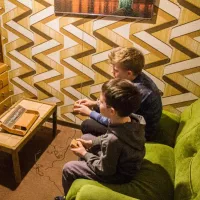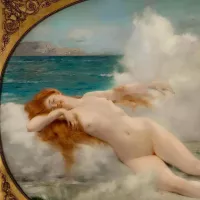Pixel art is a digital art form where images are constructed using individual pixels. It's strongly linked to the low-resolution graphics of early computers, arcade games, and consoles with limited pixels and color palettes. Despite technological advancements, pixel art remains popular among artists and game developers today, showcasing its enduring appeal beyond its original limitations.
1937: Monochromatic light bulb matrix displays extant
Circa 1937, simple monochromatic light bulb matrix displays were used in analog electronic advertising displays, such as those in New York City.
1972: SuperPaint system
In 1972, Richard Shoup developed the SuperPaint system at Xerox PARC, showcasing early pixel art practices.
1978: Release of Space Invaders
In 1978, Space Invaders was released, marking a significant moment in the golden age of arcade video games and pixel art's origins.
1980: Release of Pac-Man
In 1980, Pac-Man was released, contributing to the development of pixel art during the golden age of arcade video games.
1982: Pixel art term published
In 1982, the term "pixel art" was first published in a journal letter by Adele Goldberg and Robert Flegal of Xerox Palo Alto Research Center.
1983: Release of Nintendo Entertainment System
In 1983, the Nintendo Entertainment System was released, and it became influential in the development of pixel art.
1985: Deluxe Paint released
In 1985, Deluxe Paint for the Commodore Amiga was released, inspiring many later pixel artists to create digital art by careful placement of pixels.
1985: Release of Master System
In 1985, the Master System was released, and it contributed to the development of pixel art.
1986: Releases of DEGAS Elite and Deluxe Paint 2
In 1986, DEGAS Elite for the Atari ST and Deluxe Paint 2 for the Commodore Amiga were released. These software tools inspired many later pixel artists to create digital art.
1987: Hired by Lucasfilm Games
In 1987, someone was hired by Lucasfilm Games to do artwork for their computer games, at this time pixel graphics was not considered an art form.
2011: Releases of Superbrothers: Sword & Sworcery EP and Terraria
In 2011, the release of retro pixel art games Superbrothers: Sword & Sworcery EP and Terraria contributed to the increased popularity of pixel art.
2012: Release of Fez
In 2012, Fez was released, contributing to the increased popularity of pixel art.
2012: The Art of Video Games exhibition at the Smithsonian
In 2012, The Smithsonian Institution museum of Washington created an exhibition called The Art of Video Games, which was attended by almost 700,000 people.
2013: Release of Papers, Please
In 2013, Papers, Please was released, contributing to the increased popularity of pixel art.
2014: Release of Shovel Knight
In 2014, Shovel Knight was released, contributing to the increased popularity of pixel art.
2015: Release of Undertale
In 2015, Undertale was released, contributing to the increased popularity of pixel art.
2016: Releases of Owlboy and Stardew Valley
In 2016, Owlboy and Stardew Valley were released, contributing to the increased popularity of pixel art.
2018: Releases of Deltarune, Celeste, and Octopath Traveler
In 2018, Deltarune, Celeste, and Octopath Traveler were released, contributing to the increased popularity of pixel art.
2021: Releases of Eastward and Loop Hero
In 2021, Eastward and Loop Hero were released, which are games that use pixel art.
2022: Release of Vampire Survivors
In 2022, Vampire Survivors was released. It is a game that uses pixel art.
2022: Pixelation announces closing of webforum
In the early fall of 2022, Pixelation announced the closing of its webforum and a transition to Twitter.
2023: Releases of Pizza Tower, Blasphemous 2, and Dave the Diver
In 2023, Pizza Tower, Blasphemous 2, and Dave the Diver were released, which are games that use pixel art.
2024: Releases of Balatro and Antonblast
In 2024, Balatro and Antonblast were released, which are games that use pixel art.
Mentioned in this timeline

Adele Laurie Blue Adkins is a highly acclaimed English singer-songwriter...

Nintendo is a Japanese multinational video game company based in...

A video game is an electronic game involving user interaction...
Trending

8 months ago Heavy Rainfall and Storms Expected Through Mother's Day Weekend; Flood Watch Issued

Ted Danson is a celebrated American actor best known for his iconic role as Sam Malone in the sitcom Cheers...

5 months ago Avengers: Doomsday Rumors Surface: Agatha Return, Doctor Doom Threat, Nick Fury Back?

1 month ago Jason Statham's 'A Working Man' achieves streaming success despite mixed reviews, replacing The Beekeeper.

3 months ago Seth Rogen's 'Platonic' success and Chris Evans's audition fail stories revealed.
25 days ago Marty Supreme, Avatar, and Timothée Chalamet among December's most anticipated movie releases.
Popular

XXXTentacion born Jahseh Dwayne Ricardo Onfroy was a controversial yet...

Ben Shapiro is a prominent American conservative political commentator media...

Tucker Carlson is an American conservative political commentator known for...

Candace Owens is an American conservative political commentator and author...

William Franklin Graham III commonly known as Franklin Graham is...
The Kennedy Center Honors are annual awards recognizing individuals and...
